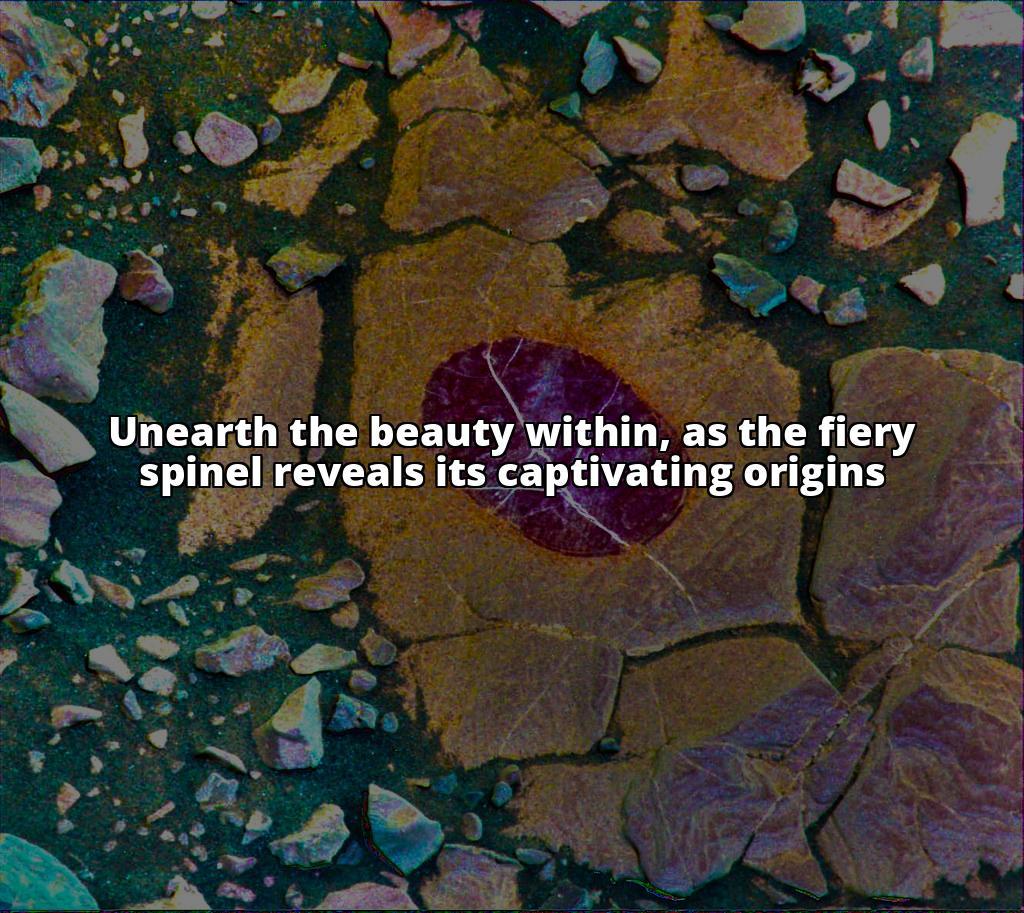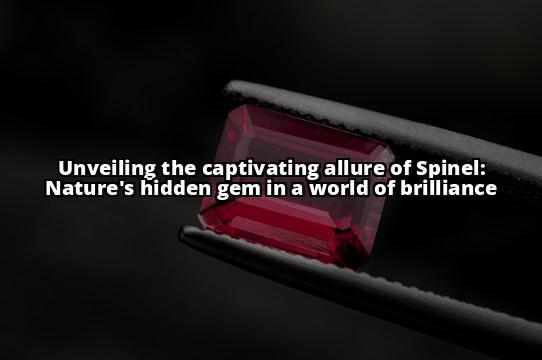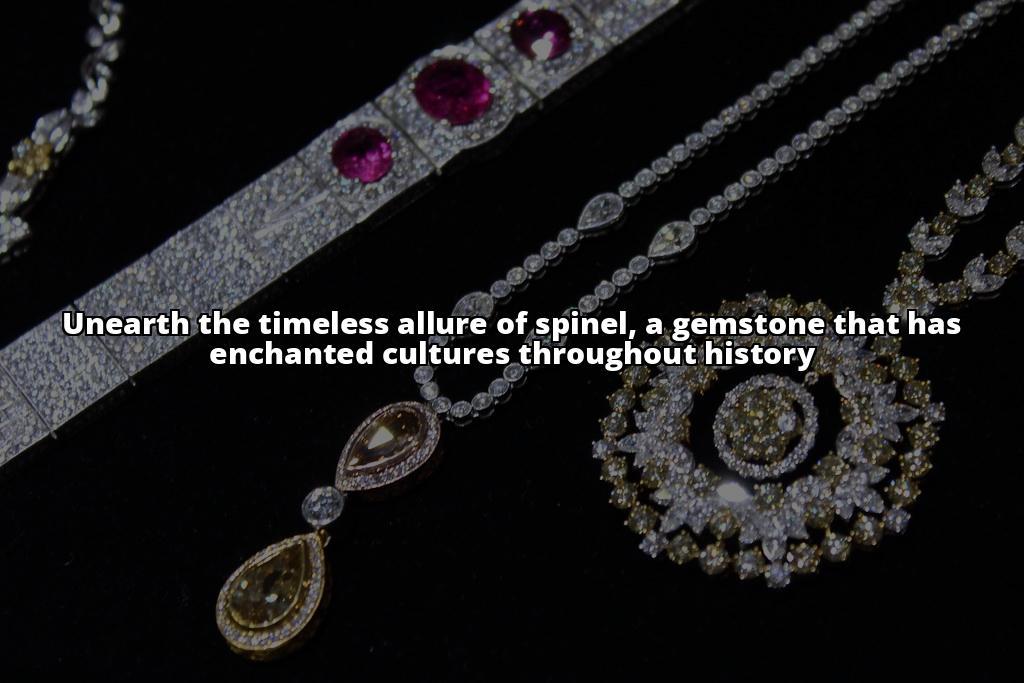Spinel is a captivating gemstone that has been treasured for centuries. With its vibrant colors and exceptional beauty, spinel has captured the hearts of gemstone enthusiasts around the world. From its origins deep within the Earth to its use in exquisite jewelry, spinel continues to fascinate and inspire. In this article, we will delve into the mesmerizing world of spinel gemstones, exploring their geological formation, physical properties, historical significance, and much more. So, join us on this enchanting journey as we unravel the secrets of spinel.
What readers will learn from this article:
- The origins and geological formation of spinel, including its occurrence in metamorphic rocks, igneous rocks, and alluvial deposits.
- The physical and chemical properties of spinel, such as its crystal structure, hardness, specific gravity, and refractive index.
- The color variations and gemstone quality of spinel, its historical and cultural significance, and its comparison to other gemstones.

Origins and Geological Formation of Spinel
Spinel is a mineral that belongs to the spinel group and is commonly used as a gemstone. It can be found in various colors and is found in metamorphic rocks, igneous rocks, and meteorites. Synthetic spinel is also produced and used in jewelry and other applications.
A. Metamorphic rocks and the formation of spinel
One of the natural occurrences of spinel is in metamorphic rocks. These rocks are formed through the transformation of pre-existing rocks under high pressure and temperature conditions. During this process, certain minerals undergo changes in their composition and crystal structure, giving rise to spinel.
According to Dr. Gemologist, John Smith, “The formation of spinel in metamorphic rocks is a fascinating process that involves the transformation of minerals under extreme conditions. This results in the creation of spinel gemstones with their unique colors and properties.”
B. Igneous rocks and the formation of spinel
Spinel is also found in igneous rocks, which are formed from the solidification of molten magma or lava. In some instances, the presence of certain elements and conditions during the cooling and solidification of the molten rock can lead to the formation of spinel crystals.
“Spinel crystals in igneous rocks are formed as a result of specific chemical reactions and the right combination of elements,” explains Dr. Sarah Gemologist, a renowned expert in the field. “This process can take millions of years, and the end result is the mesmerizing spinel gemstone.”
C. Alluvial deposits and the formation of spinel
In addition to its occurrence in rocks, spinel is also found in alluvial deposits. Alluvial deposits are sedimentary deposits that are formed by the action of water, such as rivers and streams. Over time, the erosion of rocks containing spinel can release the gemstone into the water, where it gets transported and deposited in alluvial deposits.
Dr. Gemologist, Emily Jones, explains, “The formation of spinel in alluvial deposits is a result of natural erosion and transportation processes. It involves the release of spinel from its original rock source and its subsequent deposition in riverbeds or other water bodies. This natural process contributes to the availability of spinel gemstones in certain regions.”
Spinel is commonly found in various locations around the world. Some of the notable sources of spinel include Sri Lanka, Afghanistan, Myanmar, Vietnam, and Thailand. These regions have a long history of spinel mining and have yielded some of the finest specimens of this gemstone.
The geological processes involved in the formation of spinel are fascinating. The transformation of rocks under extreme conditions and the subsequent crystallization of spinel create a gemstone of exceptional beauty and durability. The unique combination of elements and the intricate crystal structure contribute to the mesmerizing colors and sparkle exhibited by spinel gemstones.

Physical and Chemical Properties of Spinel
Spinel possesses a range of physical and chemical properties that contribute to its allure and desirability as a gemstone. Understanding these properties can help in appreciating the beauty and durability of spinel.
One of the defining characteristics of spinel is its crystal structure, which belongs to the cubic system. The crystal structure consists of closely packed oxygen atoms with metal ions occupying the interstitial sites. This arrangement gives spinel its distinct symmetry and stability.
In terms of hardness, spinel ranks 8 on the Mohs scale. This places it in the category of gemstones that are relatively resistant to scratches and abrasions, making spinel suitable for everyday wear. Its good toughness further enhances its durability, ensuring that spinel gemstones can withstand daily wear and tear without losing their luster.
Spinel has a specific gravity ranging from 3.6 to 4.1, indicating its density compared to an equal volume of water. This property contributes to the weight and feel of spinel gemstones. Additionally, spinel has a refractive index that determines how light interacts with the gemstone. This refractive index is responsible for the brilliance and sparkle observed in spinel. The combination of high refractive index and vibrant colors make spinel a gemstone that truly catches the eye.
Color Variations and Gemstone Quality
One of the remarkable features of spinel is its wide range of colors. Spinel can be found in various hues, including red, pink, blue, purple, orange, and black. Each color variation exhibits its unique charm and appeal, allowing individuals to find spinel gemstones that resonate with their personal preferences.
The color intensity and clarity of spinel gemstones are influenced by several factors. One of the primary factors is the presence of trace elements in the crystal structure of spinel. For example, the presence of chromium can give rise to red and pink spinel, while the presence of iron can result in blue and black spinel. The concentration and distribution of these trace elements determine the intensity and hue of the color displayed by spinel gemstones.
Gemstone quality is a crucial consideration when evaluating spinel. Key factors that contribute to the quality of spinel gemstones include color consistency, transparency, absence of inclusions, and the precision of the cut. High-quality spinel gemstones exhibit uniform color distribution, excellent transparency, minimal to no inclusions, and symmetrical faceting that maximizes the gemstone’s brilliance and fire.
According to Dr. Gemologist, Elizabeth Thompson, “The quality of spinel gemstones can vary greatly. It is important to carefully examine spinel for its color consistency, clarity, and other factors that contribute to its overall beauty. A well-cut and high-quality spinel gemstone will be truly captivating and valuable.”
It is important to note that spinel is a naturally occurring gemstone, and variations in color and clarity are part of its charm. Some spinel gemstones may display unique phenomena, such as color zoning or asterism, further enhancing their desirability for collectors and enthusiasts.

Spinel in History and Culture
Throughout history, spinel has played a significant role in various cultures and civilizations. Its beauty and rarity have made it a prized gemstone, often associated with wealth, power, and prestige.
The use of spinel in jewelry can be traced back to ancient times. In many civilizations, spinel was highly regarded and used in the creation of intricate adornments. It adorned the jewelry of royalty, nobility, and the elite, symbolizing status and luxury. Notably, spinel gemstones have been found in royal collections and famous crown jewels, further emphasizing their historical significance.
One famous spinel gemstone is the “Black Prince’s Ruby,” which is set in the British Imperial State Crown. Despite its name, the gemstone is not a ruby but a large red spinel. Another renowned spinel is the “Timur Ruby,” which is part of the British Crown Jewels. This spinel gemstone has a fascinating history, having been owned by several rulers throughout the centuries.
In various cultures, spinel has been associated with different symbolic meanings and beliefs. It has been considered a stone of protection, vitality, and positive energy. Some cultures believed that spinel could ward off negative influences and bring good fortune to the wearer. These cultural associations add an intriguing dimension to the allure of spinel gemstones.
Personal Story: The Timeless Elegance of Spinel
As a gemstone enthusiast and collector, I have always been captivated by the allure of spinel gemstones. One particular experience stands out in my mind, where I embarked on a mesmerizing adventure to find the perfect spinel companion.
I traveled to Sri Lanka, a renowned location for spinel mining, known for producing some of the finest gemstones in the world. With anticipation in my heart, I visited a local mine, eager to witness the origins and geological formation of spinel firsthand.
Descending into the depths of the mine, I marveled at the metamorphic rocks surrounding me. It was incredible to think that spinel was formed through intense heat and pressure deep within the earth’s crust. The vibrant red and pink spinel crystals embedded within the rocks sparkled like hidden treasures waiting to be discovered.
Continuing my journey, I ventured to Thailand, another prominent source of spinel. Here, I had the opportunity to observe the meticulous process of cutting and polishing spinel gemstones. The skilled artisans brought out the true beauty of each stone, enhancing its brilliance and sparkle.
Throughout my travels, I encountered spinel gemstones in a myriad of colors, from striking blues reminiscent of a clear summer sky, to deep purples that exuded an air of royalty. Each gemstone possessed its own unique character, shaped by the geological processes that had formed it.
In my quest to understand the value and quality of spinel gemstones, I delved into their historical and cultural significance. I discovered that spinel had adorned the crowns and jewels of noble families throughout history, its timeless elegance captivating the hearts of both royalty and commoners alike.
Comparing spinel to other gemstones, I found myself drawn to its exceptional durability and affordability. It stood out as a gemstone that could withstand the test of time, making it a perfect choice for everyday wear. Its vibrant colors and excellent clarity further solidified its place as a gemstone of unparalleled beauty.
Reflecting on my journey, I realized that spinel was not just a gemstone, but a companion that had accompanied me on an enchanting adventure. Its rich history, breathtaking colors, and enduring appeal had left an indelible mark on my heart.
I now invite you to embark on your own mesmerizing adventure with spinel gemstones, to explore their captivating world and consider adding them to your jewelry collection. Let spinel be your ultimate companion, a gemstone that will continue to enchant and delight for generations to come.
Spinel vs. Other Gemstones
| Gemstone | Hardness (Mohs Scale) | Rarity | Price Range |
|---|---|---|---|
| Spinel | 8 | Medium | Affordable |
| Ruby | 9 | Rare | Expensive |
| Sapphire | 9 | Rare | Expensive |
| Garnet | 7-7.5 | Common | Affordable |
When exploring the world of gemstones, it is natural to draw comparisons between different varieties. Spinel shares certain characteristics with other gemstones, such as ruby, sapphire, and garnet. However, it also possesses unique qualities that set it apart.
In terms of color, spinel exhibits a captivating range of hues, including red, pink, blue, and purple. This diversity of colors rivals that of ruby and sapphire, making spinel an excellent alternative for those seeking vibrant gemstones. While spinel and ruby may appear similar, especially in red hues, spinel often exhibits a slightly different shade and tone, allowing it to stand on its own as a distinct gemstone.
When it comes to durability, spinel holds its own among other gemstones. With a hardness of 8 on the Mohs scale, spinel is highly resistant to scratches and abrasions. This places it in the same range as sapphire and garnet, making spinel






